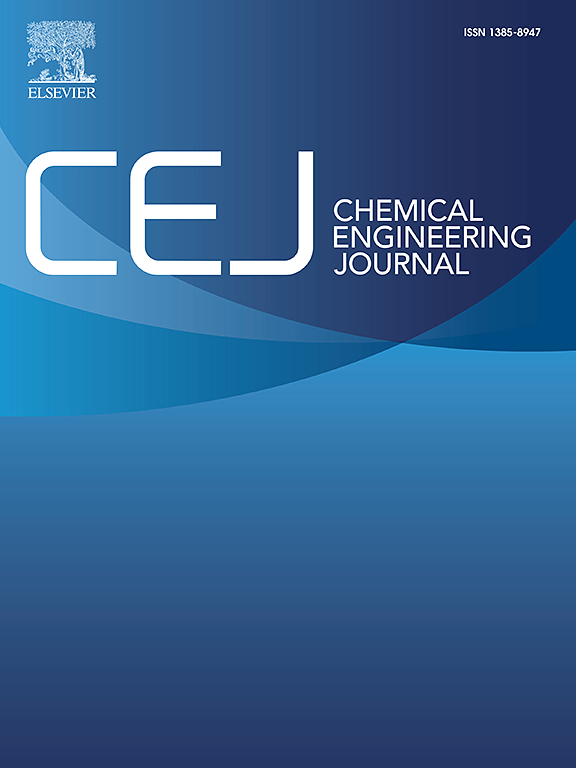Visualizing the macroscale dispersion of graphene based sheets in epoxy anticorrosive coatings by fluorescence quenching
IF 13.2
1区 工程技术
Q1 ENGINEERING, CHEMICAL
引用次数: 0
Abstract
Graphene-based sheets have garnered significant interest due to their exceptional thermal, mechanical, and barrier properties. A general and straightforward visualization approach that facilitates the rapid observation and quantification of the macroscale dispersion of graphene within a polymer matrix would be advantageous, as it can elucidate the intrinsic relationship between macroscale dispersion and the corrosion resistance of composites. In this work, we propose a fast, simple, and efficient strategy to directly observe and quantitatively evaluate the macroscale three-dimensional spatial dispersion of graphene oxide (GO) in epoxy coatings. This is achieved by quenching the emission from the intrinsic luminescent epoxy coatings, as observed in confocal laser scanning microscopy (CLSM), in conjunction with the Morisita index and particle spacing probability density theory. Statistical analysis revealed that the content of 0.1 ∼ 0.25 wt% represents the threshold for uniform dispersion of GO, attributed to the interactions of inter-particle van der Waals forces and physical entanglement. The dispersion of GO in epoxy coatings with a content below this threshold gradually improves during the immersion process, whereas the dispersion of GO at a content above the threshold significantly deteriorates. The electrochemical results are consistent with the findings obtained through direct observation and quantitative evaluation using CLSM, indicating that the epoxy composite coating containing 0.1 ∼ 0.25 wt% GO exhibits long-term protective performance due to its favorable dispersion state. This study presents a valuable opportunity and inspiration for the quantitative evaluation of nanoparticle dispersion within coatings. It also serves as a reference for establishing a relationship between the dispersion state of two-dimensional nanomaterials in coatings and the corrosion resistance of those coatings.


用荧光猝灭法观察石墨烯基薄片在环氧防腐涂料中的宏观分散
石墨烯基薄片由于其特殊的热、机械和阻隔性能而引起了人们的极大兴趣。一种通用的、直观的可视化方法有助于快速观察和量化石墨烯在聚合物基体中的宏观分散,因为它可以阐明宏观分散与复合材料耐腐蚀性之间的内在关系。在这项工作中,我们提出了一种快速、简单、高效的策略来直接观察和定量评估氧化石墨烯(GO)在环氧涂料中的宏观三维空间分散。这是通过猝灭本征发光环氧涂层的发射来实现的,正如在共聚焦激光扫描显微镜(CLSM)中观察到的那样,结合Morisita指数和粒子间距概率密度理论。统计分析表明,0.1 ~ 0.25 wt%的含量代表了氧化石墨烯均匀分散的阈值,这归因于粒子间范德华力和物理纠缠的相互作用。当氧化石墨烯含量低于该阈值时,氧化石墨烯在环氧涂料中的分散性在浸泡过程中逐渐改善,而高于该阈值时,氧化石墨烯的分散性明显恶化。电化学结果与CLSM直接观察和定量评价结果一致,表明含有0.1 ~ 0.25 wt%氧化石墨烯的环氧复合涂层由于其良好的分散状态而具有长期的保护性能。本研究为纳米颗粒在涂层中的分散提供了一个有价值的定量评价机会和启示。为建立二维纳米材料在涂层中的分散状态与涂层耐蚀性之间的关系提供了参考。
本文章由计算机程序翻译,如有差异,请以英文原文为准。
求助全文
约1分钟内获得全文
求助全文
来源期刊

Chemical Engineering Journal
工程技术-工程:化工
CiteScore
21.70
自引率
9.30%
发文量
6781
审稿时长
2.4 months
期刊介绍:
The Chemical Engineering Journal is an international research journal that invites contributions of original and novel fundamental research. It aims to provide an international platform for presenting original fundamental research, interpretative reviews, and discussions on new developments in chemical engineering. The journal welcomes papers that describe novel theory and its practical application, as well as those that demonstrate the transfer of techniques from other disciplines. It also welcomes reports on carefully conducted experimental work that is soundly interpreted. The main focus of the journal is on original and rigorous research results that have broad significance. The Catalysis section within the Chemical Engineering Journal focuses specifically on Experimental and Theoretical studies in the fields of heterogeneous catalysis, molecular catalysis, and biocatalysis. These studies have industrial impact on various sectors such as chemicals, energy, materials, foods, healthcare, and environmental protection.
 求助内容:
求助内容: 应助结果提醒方式:
应助结果提醒方式:


